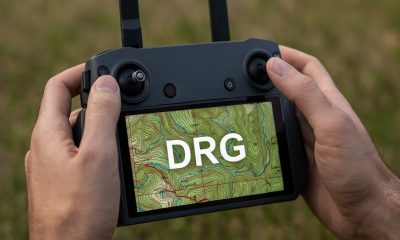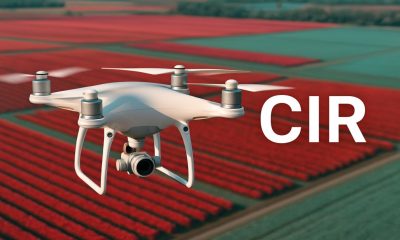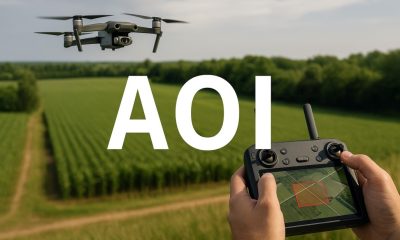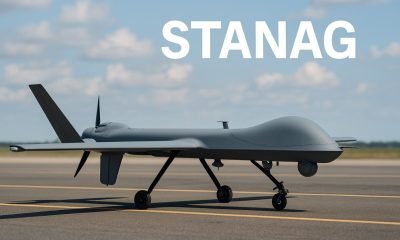- Acronym Guide
- AAM
- ABS
- AC
- ACAS
- ADS-B
- AFAC
- AGL
- AI
- AIM
- ALS
- AM
- AMA
- ANSP
- AOI
- APPI
- AUV
- AUVSI
- ARPAS-UK
- ASTM
- ATC
- BVLOS
- CAA
- CAAC
- CAB
- CASA
- CATT
- CBO
- CBR
- CBRN
- CDMA
- CDR
- CFR
- CIR
- COA
- COMINT
- CORS
- COTP
- COTR
- CPTED
- CV
- C2
- DAA
- DEM
- DFI
- DFS
- DGCA
- DHS
- DOD
- DPA
- DPEs
- DRG
- DRO
- DSM
- DSMX
- DSP
- DSSS
- DTM
- EASA
- EFT
- EO
- EOD
- EO/IR
- ELINT
- EMI
- ESC
- EVLOS
- eVTOLs
- FAA
- FCC
- FCS
- FHSS
- FICCI
- FLIR
- FOB
- FOV
- FPS
- FPV
- GBDAA
- GCP
- GCS
- GDPR
- GML
- GNSS
- GPS
- GSD
- GVC
- HDR
- HOGE
- IACRA
- ICAO
- ICS
- IMU
- INS
- IR
- ISA
- ISR
- ITU
- JARUS
- LAAMS
- LAANC
- LAATM
- LAI
- LBA
- LIDAR
- LOS
- LSALT
- MAC
- MAVLink
- MLIT
- MMS
- MSL
- MTOM
- NDAA
- NCSL
- NFZ
- NIST
- NMEA
- NOTAM
- NPA
- NPRM
- NTIA
- OBIA
- OEM
- OFDM
- OOP
- PASM
- PAV
- PCV
- PdM
- PEC
- PIC
- PID
- PIPL
- PLD
- PM
- PN
- PPK
- PPS
- PSM
- PWM
- UAM
- UAOP
- UAS
- UASTM
- UAV
- UCAVs
- UHD
- UHF
- USV
- UTM
- RAIM
- RCC
- RCS
- RFI
- ReOC
- RePL
- RMS
- ROI
- RPAS
- RPC
- RTH
- RTK
- SaR
- SAR
- SARP
- SBAS
- S.Bus
- SBIR
- SEDENA
- SfM
- SFOC
- SIGINT
- SLAM
- SMS
- SORA
- STANAG
- STTR
- sUAS
- TCAS
- TCCA
- TFR
- TIN
- TOF
- TP
- TPS
- TSA
- VHF
- VLOS
- VTOL
Drone Acronyms
What is EVLOS (Extended Visual Line of Sight) & How Does it Work?
By
Jacob StonerTable Of Contents

Definition
EVLOS stands for Extended Visual Line of Sight. It refers to drone operations where the pilot maintains visual contact with the drone indirectly through the use of observers stationed at various points along the flight path, extending the operational range beyond the pilot’s direct line of sight.
Relevance to the Industry
EVLOS bridges the gap between VLOS and BVLOS operations, allowing for extended missions while still maintaining a visual oversight component. This operational mode increases the coverage area and operational efficiency, making it valuable for industries that need to survey large tracts of land or long infrastructures like pipelines and power lines.
How Does EVLOS Work?
Extended Visual Line of Sight (EVLOS) operations allow drones and unmanned aerial systems (UAS) to be flown beyond the immediate visual range of the pilot but still within an extended line of sight using visual observers. This method expands the operational range while maintaining visual contact with the aircraft. Here’s a detailed overview of how EVLOS works:
1. System Components
- Unmanned Aerial Vehicle (UAV): The drone, which can be a fixed-wing, rotary-wing (e.g., quadcopter), or hybrid aircraft.
- Ground Control Station (GCS): The control center where operators manage and monitor the UAV’s flight, typically using a handheld remote control or a computer-based interface.
- Visual Observers (VOs): Trained personnel stationed at various points to maintain visual contact with the UAV and communicate with the pilot.
- Communication Link: The data link that connects the UAV to the GCS, allowing for real-time transmission of telemetry data and control commands.
2. UAV Structure and Propulsion
- Airframe: The body of the UAV, designed for lightweight durability, aerodynamic stability, and housing all essential components.
- Propulsion System: Consists of electric motors and propellers, generating the necessary thrust for takeoff, flight, and maneuvers.
- Power Source: Typically rechargeable lithium-polymer (LiPo) batteries, supplying the energy required for flight operations.
3. Navigation and Control Systems
- Manual and Autonomous Control: The pilot controls the UAV via a remote control interface, with some EVLOS operations integrating autopilot features for enhanced stability and navigation.
- Visual Observer Coordination: VOs relay visual information to the pilot, ensuring the UAV stays within visual range at all times. They help detect and avoid obstacles, other aircraft, and ensure compliance with flight regulations.
4. Communication Systems
- Data Link: Ensures continuous communication between the UAV and the GCS, transmitting telemetry data (e.g., position, speed, altitude) and receiving control inputs from the pilot.
- Telemetry System: Provides real-time feedback on the UAV’s status, essential for monitoring and ensuring safe operations.
- Communication with VOs: The pilot maintains constant communication with VOs via radio or other communication devices, ensuring situational awareness and coordination.
5. Operational Phases
- Pre-Flight Planning: Detailed mission planning is conducted, including the placement of VOs, flight path, waypoints, altitudes, and specific tasks. Risk assessments and compliance with regulatory requirements are also ensured.
- Takeoff and Launch: The UAV is launched manually or autonomously, achieving a stable hover or initial flight path. The pilot and VOs ensure the UAV is visible and clear of obstacles.
- Mission Execution: The UAV follows the pre-defined flight path, with VOs positioned to maintain visual contact throughout the extended range. The pilot makes real-time adjustments based on input from VOs and telemetry data.
- Data Collection or Task Performance: The UAV performs its mission, such as capturing images, videos, or other data. VOs help ensure the UAV remains within the extended visual line of sight.
- Landing and Recovery: The UAV returns to the designated landing area, guided by the pilot with input from VOs to ensure a safe and controlled descent and landing.
6. Applications and Use Cases
- Infrastructure Inspection: Inspecting extended infrastructure such as power lines, pipelines, and railways over longer distances than typical VLOS allows.
- Surveying and Mapping: Conducting detailed surveys and creating maps of large areas, such as construction sites, agricultural fields, and forested regions.
- Search and Rescue: Assisting in search and rescue operations by covering larger areas while maintaining visual contact through VOs.
- Environmental Monitoring: Collecting data on weather patterns, wildlife, and natural resources in broader regions.
- Security and Surveillance: Monitoring large areas for security purposes, border patrol, and law enforcement.
Understanding how EVLOS operations work showcases the balance between extending operational range and maintaining safety and regulatory compliance. This method leverages the capabilities of multiple visual observers to ensure the UAV remains within a controlled visual environment, enhancing the effectiveness of various drone missions.
Example in Use
“To inspect a long stretch of power lines, the utility company deployed EVLOS operations, using a team of observers to maintain continuous visual contact with the drone.”
Frequently Asked Questions about EVLOS (Extended Visual Line of Sight)
1. What is EVLOS in drone operations?
Answer: EVLOS (Extended Visual Line of Sight) in drone operations means that the pilot uses one or more observers stationed at strategic points along the drone’s flight path to maintain visual contact with the drone. This allows the drone to operate over greater distances than VLOS while still ensuring that someone has a visual on the drone at all times. EVLOS combines the safety benefits of VLOS with the extended range capabilities closer to BVLOS.
2. How does EVLOS work?
Answer: EVLOS works by deploying a network of visual observers along the intended flight path of the drone. These observers maintain direct visual contact with the drone and communicate with the pilot via radio or other communication methods. This coordinated effort ensures that as the drone moves out of the pilot’s direct sight, it remains within the visual range of an observer, thus extending the effective operational range without losing visual oversight.
3. What are the benefits of EVLOS?
Answer: The benefits of EVLOS include:
- Extended Range: Allows for longer operational distances than VLOS while maintaining visual oversight.
- Enhanced Safety: Observers can monitor the drone’s environment, helping to avoid obstacles and other hazards.
- Regulatory Compliance: Meets specific regulatory requirements for extended visual operations, providing a compliant way to conduct longer-range missions.
- Operational Flexibility: Suitable for applications requiring the inspection of long or large areas, such as power lines, pipelines, and large agricultural fields.
- Cost-Effective: Offers a cost-effective solution compared to BVLOS, which might require more advanced technology and regulatory approvals.
For examples of these acronyms visit our Industries page.
As the CEO of Flyeye.io, Jacob Stoner spearheads the company's operations with his extensive expertise in the drone industry. He is a licensed commercial drone operator in Canada, where he frequently conducts drone inspections. Jacob is a highly respected figure within his local drone community, where he indulges his passion for videography during his leisure time. Above all, Jacob's keen interest lies in the potential societal impact of drone technology advancements.











